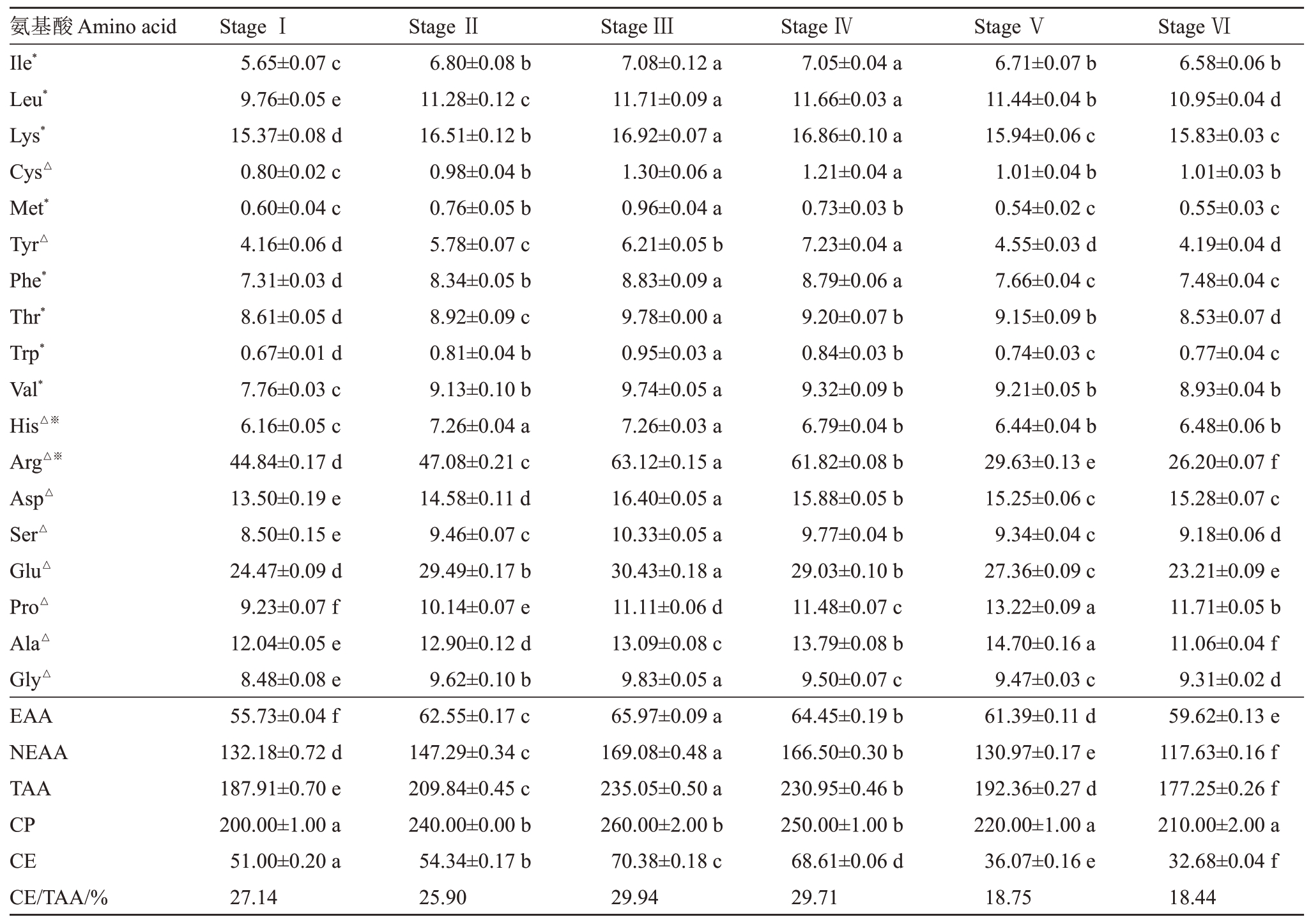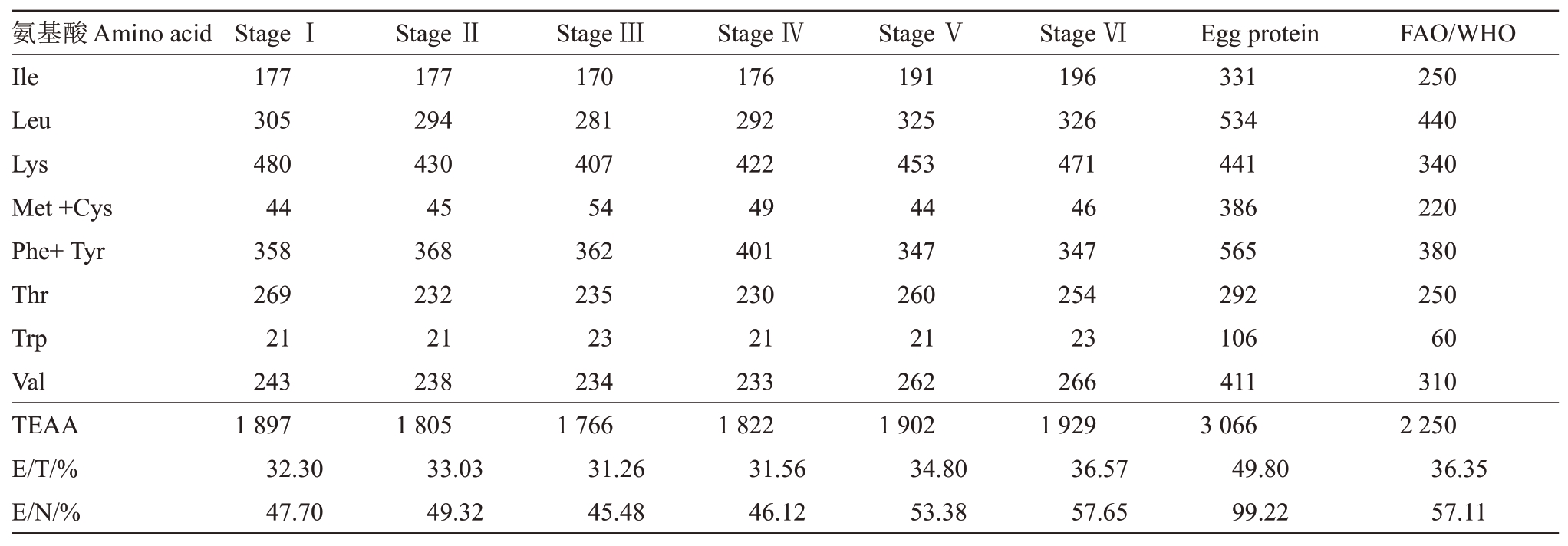葡萄(Vitis vinifera L.)是葡萄科(Vitaceae Juss)葡萄属(Vitis L.)木质藤本植物,含蛋白质、糖、有机酸、维生素及矿物质等营养成分[1-2]。‘红地球’是仅次于‘巨峰’的鲜食葡萄栽培品种,栽培规模发展迅速,已成为我国鲜食葡萄出口的第一大品种[3]。葡萄采收的成熟度对果品质量有潜在影响,直接关系果农的经济收益。因此,研究不同采摘期‘红地球’葡萄的营养变化,对指导适时采收和提高葡萄产业优质生产具有重要意义。国内外学者研究了延迟采收对葡萄果实部分营养指标的影响。王宇等[4]研究表明,随着采收期的推迟,葡萄果实的总酸呈下降趋势,可溶性固形物、总酚、花色苷及黄酮醇含量均呈上升趋势。刘亮等[5]研究表明,延迟采收的‘红地球’葡萄中可溶性固形物、总糖、还原糖和蔗糖含量有所上升,而可滴定酸含量明显减少。屠婷瑶等[6]研究发现不同采收期的‘赤霞珠’葡萄及葡萄酒中总多酚、总类黄酮含量先降低后增高,而总花色苷含量变化呈上升趋势。无核白葡萄从转色期至成熟期的整个果实成熟过程,果实中还原糖含量呈上升趋势,总酸含量呈下降趋势,单宁和总酚含量则先增后减[7]。彭媛媛等[8]发现随着采收期的延迟,新疆部分地区酿酒葡萄果实的pH、可溶性固形物含量、固酸比和糖酸比呈增大趋势。食物蛋白质营养价值的高低主要取决于必需氨基酸的种类、含量及组成比例。氨基酸是组成蛋白质的基本单位,是生命活动的基础物质,人体必须从膳食中摄取异亮氨酸等必需氨基酸,否则无法维持机体的正常生长发育[9-10]。氨基酸含量与组成特征是影响葡萄品质的重要指标之一[11]。但目前关于成熟度对葡萄氨基酸营养影响的研究尚未见报道。笔者旨在探讨成熟度对‘红地球’葡萄氨基酸营养的影响,为‘红地球’葡萄采摘及相关产品开发提供理论参考。
1 材料和方法
1.1 材料与试剂
试材来自福建龙晶生物技术有限公司葡萄园基地。棚架为钢筋结构,长70 m,宽6 m,高3 m,南北延长。‘红地球’葡萄定植于2014 年,株行距1.2 m×3 m。
选择生长势、植株干径和负载量相近的植株,盛花期为2019年5月5日,按南、中、北三个片区,挂牌标示。采样时间分别为盛花期后88、95、102、109、116、123 d[依次标记为始熟期(Stage Ⅰ)、成熟期(Stage Ⅱ)、完全成熟期Ⅰ(Stage Ⅲ)、完全成熟期Ⅱ(Stage Ⅳ)、过熟期(Stage Ⅴ)和衰老期(StageⅥ)]。在各采摘节点,随机取10 穗葡萄样品,取每穗上、中、下、内、外各部位外观无损果实10粒,保鲜带回实验室,去皮、去籽,磨碎,待测。
柠檬酸、柠檬酸钠、氯化钠、氢氧化钠、无水乙醇、盐酸、硫酸和硼酸为优级纯,其余试剂为分析纯,购自上海国药集团;氨基酸标准品购自Sigma公司;色氨酸标准品(≥99%)购自上海嘉辰化工有限公司。
1.2 仪器与设备
L-8800型氨基酸自动分析仪,日本HITACHI公司;Kjeltec 2300 型全自动凯氏定氮仪,瑞典FOSS TECATOR公司。
1.3 方法
1.3.1 蛋白质测定 参考GB 5009.5-2016《食品安全国家标准食品中蛋白质的测定》。
1.3.2 氨基酸的测定 色氨酸:称取2~3 g 试样,置于聚四氟乙烯衬管中,加入1.5 mL 4 mol·L-1氢氧化锂,置液氮中冷冻后放入水解管,抽真空封管,在(110±1)℃恒温干燥箱中,水解20 h 后,加入6.0 mol·L-1 盐酸中和,用pH 2.2柠檬酸钠缓冲液稀释定容,4 000 r·min-1离心10 min,取上清液待测。
其他氨基酸:参考GB 5009.124-2016《食品安全国家标准食品中氨基酸的测定》。
1.4 氨基酸营养评价
以鸡蛋蛋白为标准蛋白,以WHO/FAO 氨基酸参考模式为评价标准进行氨基酸营养评价。氨基酸评分(amino acid score,AAS)、化学评分(chemical score,CS)、氨基酸比值(amino acid ratio,RC)、氨基酸比值系数(amino acid ratio coefficient,RCAA)和氨基酸比值系数分(amino acid ratio coefficient score,SRC)等参数的计算参考文献[12-13]。
1.5 数据处理与分析
试验数据利用Excel处理,结果以平均值±标准差(Mean±SD)表示。采用SPSS 17.0进行统计分析,比较组间差异显著性。
2 结果与分析
2.1 氨基酸含量及其种类
‘红地球’葡萄的氨基酸组成如表1所示。由于天冬酰胺(Asn)和谷氨酰胺(Gln)在酸水解时会降解为天冬氨酸(Asp)和谷氨酸(Glu),故‘红地球’葡萄至少包含18 种蛋白质氨基酸,其中8 种为必需氨基酸。在整个成熟期,必需氨基酸和非必需氨基酸含量分别介于557.3~659.7、1 176.3~1 690.8 mg·kg-1,且均呈先升后降的趋势,组间差异显著(p <0.05),在完全成熟期Ⅰ二者含量均最高。在必需氨基酸中精氨酸(Arg)含量最高,其次为Glu、赖氨酸(Lys),蛋氨酸(Met)含量最低。在6个果实采收期中,Arg、脯氨酸(Pro)和丙氨酸(Ala)含量组间差异显著(p <0.05)。此外,除酪氨酸(Tyr)、Pro和Ala外,其他种类氨基酸含量均在完全成熟期Ⅰ达到峰值、完全成熟期Ⅱ次之。
表1 不同成熟期‘红地球’葡萄的氨基酸含量
Table 1 The contents of amino acids in‘Red Globe’grape with different maturities(n=3)(mg·100 g-1)

注:*. 必需氨基酸(EAA);△. 非必需氨基酸(NEAA);※. 儿童必需氨基酸(CE);CP.蛋白质;TAA. 氨基酸总量。
Note: *. Essential amino acids(EAA); △. non essential amino acids(NEAA); ※. The children essential amino acid(CE); CP. Crude protein;TAA.Total amino acids.
?
除常见的8 种必需氨基酸,‘红地球’葡萄还含有Arg和His两种儿童必需氨基酸,其含量为326.8~703.8 mg·kg-1,占氨基酸总量的18.44%~29.94%,呈先升后降的趋势,组间差异显著(p <0.05),在完全成熟期Ⅰ含量最高。
2.2 风味氨基酸含量及组成
按照味觉强度划分,氨基酸中含有5 种甜味类氨基酸、8种苦味类氨基酸和2种鲜味类氨基酸。由于氨基酸的味觉阈值差异,风味氨基酸含量对食品风味的贡献并不一定呈正相关。可通过风味氨基酸含量与其味觉阈值的比值(ratio of content and taste threshold,RCT)来评价其对食品风味的贡献[10]。RCT<1 表示该氨基酸对风味无贡献,RCT ≥1 时氨基酸才对其风味有贡献,比值越大贡献率越高。由表2 可知,在整个成熟期,Arg、Asp 和Glu 三种氨基酸的RCT值均大于1,对葡萄风味贡献率高;上述三种氨基酸在整个成熟期呈先升后降的趋势,且完全成熟期Ⅰ的RCT 值最高;其他12 种氨基酸的RCT值均小于1。
表2 不同成熟期‘红地球’葡萄的风味氨基酸含量阈值比
Table 2 The threshold ratio of flavor amino acids in‘Red Globe’grape at different maturities

注:SWAA. 甜味类氨基酸总量;BIAA. 苦味类氨基酸总量;SOAA. 酸味类氨基酸总量。
Note:SWAA.Sweet amino acids;BIAA.Bitter amino acids;SOAA.Sour amino acids.
?
2.3 特殊功效氨基酸含量及组成
特殊功效氨基酸包括药用氨基酸、支链氨基酸、芳香族氨基酸、增香与着色氨基酸、伯氨基氨基酸等。‘红地球’葡萄成熟过程特殊功效氨基酸变化情况详见表3。
表3 不同成熟期‘红地球’葡萄的特殊功效氨基酸含量
Table 3 The contents of special functional amino acids in‘Red Globe’grape at different maturities

注:MAA. 药用氨基酸(Asp、Glu、Gly、Met、Leu、Phe、Tyr、Lys、Arg);BCAA. 支链氨基酸(Ile、Leu、Val);AAA. 芳香族氨基酸(Phe、Tyr、Trp);FCAA. 增香与着色氨基酸(Glu、Cys、Val、Leu、Lys、His、Arg);PAAA. 伯胺基氨基酸(Asp、Glu、Pro、Gly、Ala、Lys、Arg)。
Note:MAA.Medicinal amino acids(Asp,Glu、Gly,Met,Leu,Phe,Tyr,Lys,Arg);BCAA:Branched chain amino acids(Ile,Leu,Val);AAA:Aromatic amino acids(Phe,Tyr,Trp);FCAA:Flavoring and coloring amino acids(Glu,Cys,Val,Leu,Lys,His,Arg);PAAA:Primary amine amino acids(Asp,Glu,Pro,Gly,Ala,Lys,Arg).
?
药用氨基酸包括Asp 等9 种,是维持机体氮平衡所必需的。不同成熟度的‘红地球’葡萄果实中药用氨基酸总量为1 130.0~1 644.1 mg·kg-1,占氨基酸总量的63.34%~69.95%,呈先升后降的趋势,组间差异显著(p <0.05),且在完全成熟期Ⅰ含量最高。支链氨基酸具有调节组织蛋白质合成与分解、调节芳香族氨基酸进入血脑屏障和防治肝肾功能衰竭等作用,分别占成人、儿童及婴儿每日EAA 需要量的40%、41%及45%[10]。正常人体及其他哺乳动物的支/芳值为3.0~3.5,而当肝受伤时则降为1.0~1.5[13]。由表3 可知,不同采摘期‘红地球’葡萄的支链氨基酸、芳香族氨基酸总量分别为231.7~285.3、121.4~168.6 mg·kg-1,均呈先升后降的趋势,组间差异均显著(p <0.05),在果实完全成熟期二者含量最高;支/芳值维持在1.66~2.13,呈先降后升的趋势,衰老期比值最高;其中支链氨基酸占必需氨基酸总量的41.58%~44.57%,从成熟至衰老期呈平缓上升的趋势。增香与着色氨基酸的氨基与还原糖的羰基之间的羰-氨反应生成物是具有愉快香味的褐色物质,促进食品的增香与着色[10]。本研究表明,‘红地球’葡萄果实中增香与着色氨基酸总量为926.1~1 404.8 mg·kg-1,占氨基酸总量的52.25%~59.77%,呈先上升后下降的趋势,组间差异显著(p <0.05),完全成熟期Ⅰ含量最高。伯胺基氨基酸能竞争性地替代仲胺与亚硝酸盐产生范斯莱克反应,氨基酸分解为氮气和有机酸,从而抑制了二甲氨基亚硝胺的生成[10]。伯胺基氨基酸在不同采摘期下的含量为1 126.0~1 609.0 mg·kg-1,占氨基酸总量的63.53%~68.57%,呈先升后降的趋势,组间差异显著(p <0.05),在完全成熟期Ⅰ含量最高。
2.4 氨基酸营养价值评价
食品蛋白质的必需氨基酸模式与人体蛋白模式越接近,越容易被机体吸收利用,营养价值就越高。由表4可知,在整个成熟期,‘红地球’葡萄每克氮中必需氨基酸的总量为1 766~1 929 mg,E/T、E/N分别为31.26%~36.57%、45.48%~57.65%,呈先下降后上升的趋势,衰老期含量最高,明显低于鸡蛋蛋白,略高于FAO/WHO标准模式。
表4 不同成熟期‘红地球’葡萄的必需氨基酸含量与鸡蛋蛋白、FAO/WHO 标准模式的比较
Table 4 The composition of essential amino acids in‘Red Globe’grape at different maturities in
comparison with egg’s protein and FAO/WHO standard model(mg·g-1)

注:单位为每g 氮中的氨基酸含量;TEAA.必需氨基酸总量(包括Cys 和Tyr);E/T.TEAA/TAA;E/N.TEAA/(TAA-TEAA)。
Note: The unit is amino acid content per gram of nitrogen; TEAA. The total of essential amino acid (including Cys and Tyr); E/T. TEAA/TAA;E/N.TEAA/(TAA-TEAA).
?
RC>1时,表示氨基酸相对过剩;而RC<1时,表示氨基酸不足。SRC 越接近100,氨基酸营养价值越高;SRC 越小,氨基酸营养价值越低。由表5 可知,在整个成熟期,‘红地球’葡萄果实中AAS、CS、SRC 分别为11.33~14.07、18.32~24.43、49.70~57.04,均呈先升后降的趋势,Phe+Tyr、Val、Ile、Leu、Trp、Met +Cys 均表现严重不足,为限制性氨基酸,Lys、Thr相对过剩;第一限制性氨基酸为Met+Cys,在完全成熟期Ⅰ评分最高。
表5 不同成熟期‘红地球’葡萄的必需氨基酸营养价值评分
Table 5 Nutritional scores of essential amino acids in‘Red Globe’grape at different maturities

?
3 讨 论
‘红地球’葡萄果实含有18种氨基酸,与前人研究结果相一致[14-15]。在整个成熟过程中,‘红地球’葡萄的TAA、EAA含量组间差异显著,均低于石榴[16]、刺梨[17]、大果沙棘[18]等水果,而成熟期至完全成熟期Ⅱ期的TAA、EAA 均高于苹果[14]、柚[19]、宽皮柑橘[19]等水果。CE 含量组间差异均显著,远低于香蕉[14]、石榴[16]、刺梨[17]、大果沙棘[18]等水果,高于苹果[14]、桃[14]、甜橙[19]、金桔[19]、柚[19]、宽皮柑橘[19]等水果,但是CE含量比例远高于香蕉[14]、石榴[16]、刺梨[17]等多种水果。可见,成熟度对‘红地球’葡萄中氨基酸含量有明显的影响。
氨基酸在防止食品在色、香、味和外观等方面的变质、消除异臭、提高食品风味等方面,发挥着重要的作用。葡萄Arg、Asp和Glu的RCT值大于1,且高于草莓[14]、甜橙[19]等水果,对葡萄风味有重大贡献。增香与着色氨基酸占TAA 的比例远高于草莓[14]、甜橙[19]、宽皮柑橘[19]等色深气味香的水果,始熟期至完全成熟期Ⅱ期的占比超过58%。伯胺基氨基酸的比例高于中华猕猴桃[14]、余甘子[20]等水果,始熟期至完全成熟期Ⅱ期的占比超过66%,但低于柠檬[19]。因此,‘红地球’葡萄可能在食品增香剂等食品工业上具有潜在的开发前景。
氨基酸不仅具有提高食品风味的作用,而且在人体的正常生理活动中发挥着重要的作用。‘红地球’葡萄中药用氨基酸占TAA 的比例高于人参[21]、冬虫夏草[22]、枸杞[23]等中药材,始熟期至完全成熟期Ⅱ期的占比超过68%。研究还发现Arg、Glu、Lys、Asp、Ala、Pro 等6 种具有特殊功效的蛋白质氨基酸占TAA 的58.28%~64.46%,高于苹果[14]、刺梨[17]、大果沙棘[18]、甜橙[19]等水果。可见,‘红地球’葡萄存在潜在的药用价值。其中,‘红地球’葡萄中具有增强免疫力、促进肠道发育、提高抗氧化能力等生理功能的Arg[24],占TAA 的比例高于沙棘、中华猕猴桃、香蕉等水果[14];具有健脑益智作用的Glu[10],占TAA 的比例高于沙棘、苹果、樱桃等水果[10];具有促进脂肪代谢功能的Lys[25],占TAA的比例高于沙棘、中华猕猴桃、香蕉等水果[14];具有解除氨中毒作用的Asp[10],占TAA 的比例高于杨桃、龙眼等水果[20];具有抗炎和免疫调节作用的Ala[26],占TAA的比例高于沙棘、苹果、香蕉、刺梨等水果[14,17];具有抗高血压作用的Pro[10],占TAA 的比例高于苹果、桃、香蕉等水果[14,17]。可见,‘红地球’葡萄在医疗保健食品方面具有广阔的开发前景。
此外,葡萄的支链氨基酸占EAA的比例与人体组织细胞相符,且过熟期后的‘红地球’葡萄能够满足婴儿的需求。BC/A 值优于橙[14]、苹果[14]、宽皮柑橘[19],基本能满足肝受损人体的需求,其中过熟期后的‘红地球’葡萄优于鳀鱼[27]、杂交鲟[28]、欧洲鳗鲡[29]等海产品;E/T、E/N 高于沙棘、草莓、橙等水果[14,20]。根据蛋白质互补法,建议与Met+Cys相对过剩的食用菌[30-31]或Lys、Thr不足的谷物类[10]等食物搭配。
4 结 论
‘红地球’葡萄果实的氨基酸种类齐全,E/T、E/N接近FAO/WHO理想氨基酸标准,SRC为49.70~57.04。Met+Cys 为‘红地球’葡萄的第一限制氨基酸,Lys、Thr含量为相对过剩。不同成熟期葡萄果实在氨基酸组成上差异明显,可根据不同的开发利用目标,选择合适的采摘期。
[1] 刘欢,何文兵,李乔,张来珏.通化葡萄产区主栽4 个品种品质的比较[J].食品科学,2017,38(17):107-113.LIU Huan,HE Wenbing,LI Qiao,ZHANG Laijue. Comparison of quality traits of four major grape cultivars planted in Tonghua[J].Food Science,2017,38(17):107-113.
[2] 江雨.中国野生葡萄果实品质评价和主要物质组分研究[D].杨凌:西北农林科技大学,2016.JIANG Yu. Evaluation of fruit quality and study on main substance components of wild grape in China[D].Yangling:Northwest A&F University,2016.
[3] 穆维松,冯建英,田东,牟鑫.我国鲜食葡萄产业的国际贸易与国内需求形势[J].中国果树,2019(2):5-10.MU Weisong,FENG Jianying,TIAN Dong,MOU Xin. The international trade and domestic demand of the table grape industry in China[J].China Fruits,2019(2):5-10.
[4] 王宇,兰义宾,孙亮,朱保庆,何非,王军. 延迟采收对‘梅鹿辄’葡萄果实品质的影响[J].西北农业学报,2015,24(7):84-91.WANG Yu,LAN Yibin,SUN Liang,ZHU Baoqing,HE Fei,WANG Jun. Effect of extended harvest on the quality of‘Merlot’grapes [J]. Acta Agriculturae Boreali-Occidentalis Sinica,2015,24(7):84-91.
[5] 刘亮. 延迟采收对红地球葡萄树体营养和果实品质的影响[D].银川:宁夏大学,2010.LIU Liang. Effect of delayed harvest on the nutrition and fruit quality of Red Globe grape [D]. Yinchuan: Ningxia University,2010.
[6] 屠婷瑶,孟江飞,魏晓峰,鞠延伦,房玉林.山西乡宁赤霞珠葡萄最佳采收期研究[J].西北农林科技大学学报(自然科学版),2017,45(5):139-146.TU Tingyao,MENG Jiangfei,WEI Xiaofeng,JU Yanlun,FANG Yulin. Optimal harvest time of Cabernet Sauvignon grape in Xiangning,Shanxi [J]. Journal of Northwest A & F University(Natural Science Edition),2017,45(5):139-146.
[7] 吴斌,雷静,陈雅,韩琛,阿依加玛丽.吐鲁番产区无核白葡萄不同负载量及不同成熟阶段对果实品质的影响[J].农产品加工,2017(6):15-19.WU Bin,LEI Jing,CHEN Ya,HAN Chen,Ayjamal. Turpan seedless white grapes,producing a different load and different mature stage effects on fruit quality change rule [J]. Farm Products Processing,2017(6):15-19.
[8] 彭媛媛,高展,董凯向,周龙,杜展成.不同采收期对新疆焉耆盆地酿酒葡萄及葡萄酒品质的影响[J].新疆农业科学,2018,55(7):1252-1263.PENG Yuanyuan,GAO Zhan,DONG Kaixiang,ZHOU Long,DU Zhancheng. Effects of the suitable harvest time for main wine grapes and wine quality in Xinjiang Yanqi basin [J]. Xinjiang Agricultural Sciences,2018,55(7):1252-1263.
[9] 尹蓉,张倩茹,王贤萍,杨晓华.不同杏品种种仁氨基酸组成分析[J].山西农业科学,2017,45(7):1087-1090.YIN Rong,ZHANG Qianru,WANG Xianping,YANG Xiaohua.Composition analysis of amino acid in kernel of different apricot varieties [J]. Journal of Shanxi Agricultural Sciences,2017,45(7):1087-1090.
[10] 蒋莹.氨基酸的应用[M].北京:世界图书出版公司北京公司,1996.JIANG Ying. Application of amino acids [M]. Beijing: Beijing World Publishing Corporation,1996.
[11] 刘小力,李想.国内外红葡萄酒氨基酸含量比较分析与研究[J].酿酒科技,2010(1):101-103.LIU Xiaoli,LI Xiang.Comparative analysis of amino acids content in homemade red grape wine and in foreign red grape wine[J].Liquor-Making Science&Techenology,2010(1):101-103.
[12] 朱圣陶,吴坤.蛋白质营养价值评价:氨基酸比值系数法[J].营养学报,1988,10(2):187-190.ZHU Shengtao,WU Kun. Nutritional evaluation of protein: ratio coefficient of amino acid [J].Acta Nutrimenta Sinica,1988,10(2):187-190.
[13] 颜孙安,林香信,钱爱萍,姚清华.化学分析法的理想参考蛋白模式及其化学生物价研究[J].中国农学通报,2010,26(23):101-107.YAN Sun’an,LIN Xiangxin,QIAN Aiping,YAO Qinghua.The study on the ideal reference protein model of chemical analysis and biological value [J]. Chinese Agricultural Science Bulletin,2010,26(23):101-107.
[14] 夏宏义,杨勇,张永芳,李亚,阮小凤.阳丰甜柿果实营养成分和氨基酸组分分析[J].黑龙江农业科学,2015(1):116-120.XIA Hongyi,YANG Yong,ZHANG Yongfang,LI Ya,RUAN Xiaofeng. Analysis on nutritive compositions,amino acid content of Diospy ros kaki cv. Youhou fruit [J]. Heilongjiang Agricultural Science,2015(1):116-120.
[15] 杨月欣,王光亚,潘兴昌. 中国食物成分表(第一册)[M]. 北京:北京大学医学出版社,2017:216-217.YANG Yuexin,WANG Guangya,PAN Xingchang. Chinese food composition table(Book Ⅰ)[M].Beijing:Peking University Medical Press,2017:216-217.
[16] 孙锐,孙蕾,赵登超,杨莉,刘宝发,郝薪云.不同石榴品种果实的营养成分比较分析[J].食品工业科技,2015,36(2):358-361.SUN Rui,SUN Lei,ZHAO Dengchao,YANG Li,LIU Baofa,HAO Xinyun. Comparative analysis of nutritional ingredients in different kinds of pomegranate fruits [J]. Science and Technology of Food Industry,2015,36(2):358-361.
[17] 林陶,李婕羚,付远洪,杨卫灵.无籽刺梨与野生刺梨果实的氨基酸含量及组成[J].山东化工,2017,46(18):76-79.LIN Tao,LI Jieling,FU Yuanhong,YANG Weiling. Determination of amino acids in Rosa sterilis and wild Rosa roxburghii by HPLC[J].Shandong Chemical Industry,2017,46(18):76-79.
[18] 马春梅,郑兴国,邓世荣,阿尔达克,何红.大果沙棘果实中氨基酸含量的测定分析[J].防护林科技,2019(9):39-40.MA Chunmei,ZHENG Xingguo,DENG Shirong,ALDAK,HE Hong. Determination and analysis of amino acids in fruits of Hippophae rhamnoides [J]. Protection Forest Science and Technology,2019(9):39-40.
[19] 何莎莎.不同类型柑橘果实氨基酸组成分析及“三度”法营养价值评价[D].重庆:西南大学,2018.HE Shasha. Analysis of amino acid composition of different types of citrus fruits and evaluation of nutritional value by“three degree”method [D]. Chongqing: Southwest University,2018.
[20] 张伟敏,魏静,施瑞诚,张海德.诺丽果与热带水果中氨基酸含量及组成对比分析[J].氨基酸和生物资源,2008,30(3):37-41.ZHANG Weimin,WEI Jing,SHI Ruicheng,ZHANG Haide.Analysis of amino acid content and the composition in the tropical fruits and Noni fruit [J]. Amino Acids & Biotic Resources,2008,30(3):37-41.
[21] 常思佳,宁雪,王日明,杨录军,任跃英.日光温室栽培模式下不同种质来源人参单体皂苷及氨基酸对比分析[J].人参研究,2019(3):18-24.CHANG Sijia,NING Xue,WANG Riming,YANG Lujun,REN Yueying.Comparative analysis of monomeric saponins and amino acids of ginseng from different germplasm sources in solar greenhouse cultivation mode[J].Ginseng Research,2019(3):18-24.
[22] 周苏,刘磊.冬虫夏草中氨基酸含量分析[J].现代食品,2017(5):116-118.ZHOU Su,LIU Lei.Analysis of amino acids in Cordyceps sinensis[J].Modern Food,2017(5):116-118.
[23] 杨春霞. 黑果枸杞与红果枸杞氨基酸含量的差异性研究[J].食品研究与开发,2017,38(4):34-37.YANG Chunxia.Comparative analysis of amino acid contents in Lycium ruthenicum Murr. and red wolfberry [J]. Food Research and Development,2017,38(4):34-37.
[24] 徐明明,刘耀文,曲湘勇.精氨酸的生理功能及其在肉鸡生产中的应用[J].广东饲料,2017,26(3):29-32.XU Mingming,LIU Yaowen,QU Xiangyong. Physiological function of arginine and its application in broiler production [J].Guangdong Feed,2017,26(3):29-32.
[25] 王兴蕾,梁飘飘,赵敏杰,冯金朝,刘颖.内蒙古阿拉善左旗六种常见沙生植物的营养成分与氨基酸组成分析[J].光谱学与光谱分析,2019,39(1):204-209.WANG Xinglei,LIANG Piaopiao,ZHAO Minjie,FENG Jinchao,LIU Ying. Analysis of nutritional compositions and amino acid compositions of 6 common psammophytes in Alxa left Banner,Inner Mongolia[J].Spectroscopy and Spectral Analysis,2019,39(1):204-209.
[26] 杜瑞平,张兴夫,高民,敖长金.甘氨酸的免疫调节作用及其分子机制[J].动物营养学报,2015,27(3):663-670.DU Ruiping,ZHANG Xingfu,GAO Min,AO Changjin. Immunomodulatory effects of glycine and its molecular mechanism[J].Acta Zoonutrimenta Sinica,2015,27(3):663-670.
[27] 刘海珍,罗琳,蔡德陵,刘道辰.不同生长阶段鳀鱼肌肉营养成分分析与评价[J].核农学报,2015,29(11):2150-2157.LIU Haizhen,LUO Lin,CAI Deling,LIU Daochen. Analysis and valuation of nutrient components in the muscle of Engraulis japonicus at different growth stages [J]. Acta Agriculturae Nucleatae Sinica,2015,29(11):2150-2157.
[28] 张美彦,曾圣,杨星,王艳艳,赵飞,杨兴.不同生长阶段杂交鲟肌肉营养成分的比较研究[J].动物营养学报,2019,31(9):4378-4386.ZHANG Meiyan,ZENG Sheng,YANG Xing,WANG Yanyan,ZHAO Fei,YANG Xing.Comparative study on nutrient components in muscle of hybrid sturgeon at different growth stages[J].Chinese Journal of Animal Nutrition,2019,31(9):4378-4386.
[29] 罗鸣钟,关瑞章,靳恒.五种鳗鲡的含肉率及肌肉营养成分分析[J].水生生物学报,2015,39(4):714-722.LUO Mingzhong,GUAN Ruizhang,JIN Heng.Analysis on the ratio of flesh content and the nutritional composition in the muscle of five species of eel [J].Acta Hydrobiologica Sinica,2015,39(4):714-722.
[30] 李巧珍,吴迪,陈明杰,李玉,宋晓霞,周峰,李正鹏,杨焱.猴头菌子实体不同发育阶段蛋白质营养价值评价[J].农产品加工,2015(6):53-56.LI Qiaozhen,WU Di,CHEN Mingjie,LI Yu,SONG Xiaoxia,ZHOU Feng,LI Zhengpeng,YANG Yan.Nutritional assessment of protein from H. erinaceus fruit bodies harvested at different developmental stages [J]. Farm Products Processing,2015 (6):53-56.
[31] 何炎炘,李能树.安徽省主栽食用菌氨基酸含量的研究[J].安徽农学通报,2015,21(2):13-15.HE Yanxin,LI Nengshu. Research on the amino acid content of main cultivated mushroom in Auhui province[J].Auhui Agricultural Science Bulletin,2015,21(2):13-15.